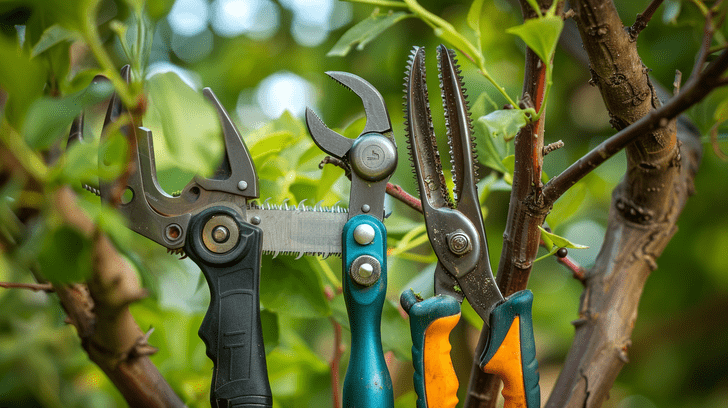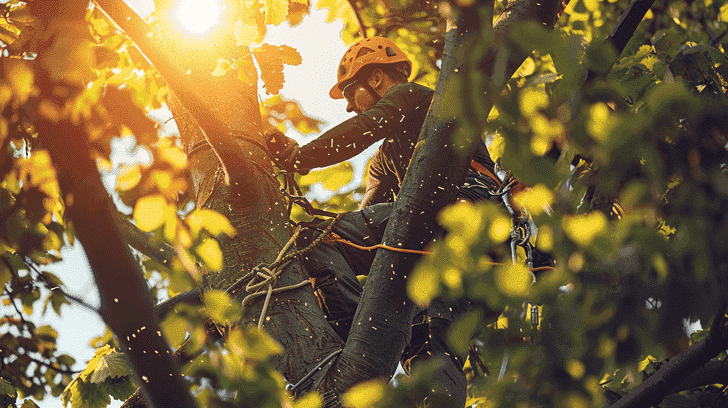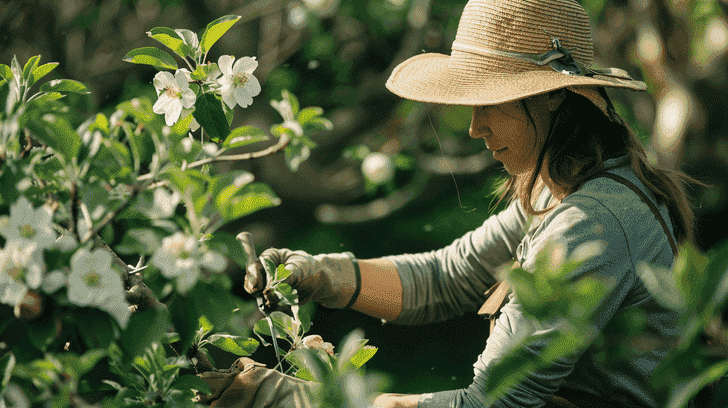How to Clean Tree Trimming Tools: Best Practices and Techniques
To clean tree trimming tools effectively, start by gathering supplies like a brush, warm soapy water, and disinfectants. Scrub off dirt and sap, then soak the tools. Remember to sharpen blades and wipe dry.
Create a clean workspace by organizing and lubricating tools. Proper storage prevents damage. Disinfect regularly to stop disease spread. Troubleshoot rust or stubborn residues promptly.
By following these practices, you can maintain tool effectiveness and plant health. Mastering the cleaning process guarantees longevity and peak performance of your tools.
Cleaning Process for Tree Trimming Tools
To start the cleaning process for your tree trimming tools, gather the necessary supplies such as a bucket, mild detergent, a scrubbing brush, and a clean cloth.
Begin by inspecting your tools for any dirt, sap, or residue buildup. Then, proceed to scrub the tools with the detergent and brush, ensuring to remove all debris before rinsing them thoroughly.
Gather Necessary Supplies
What supplies are essential for the cleaning process of tree trimming tools?
When preparing to clean your tree trimming tools, gather the necessary supplies to guarantee a thorough cleaning process. You’ll need items such as:
- A stiff-bristled brush or wire brush to remove dirt and sap residue
- A bucket filled with warm soapy water for soaking the tools
- A clean cloth for wiping down the tools
- A sharpening tool to address any dull or nicked blades
Additionally, have disinfecting products on hand such as:
- Rubbing alcohol
- Chlorine bleach
- Pine oil
These supplies will help sanitize the tools and prevent the spread of pathogens. By having these supplies ready, you can efficiently clean and maintain your tree-trimming equipment for peak performance.
Preparing the Workspace
When preparing your workspace for cleaning tree trimming tools, focus on the key points:
- the cleaning procedure
- lubricating moving parts
- storing cleaned tools properly
Make sure you have all the necessary supplies ready, such as cleaning solutions, lubricants, and storage containers.
Organizing your workspace efficiently will streamline the cleaning process and help maintain the tools in good condition for future use.
Cleaning Procedure
Prepare your workspace by clearing any debris and organizing your tools before starting the cleaning procedure for tree trimming tools. Removing clutter guarantees a safe and efficient workspace.
Begin by sweeping away leaves, twigs, and any other debris that could interfere with the cleaning process. Organize your tools in a designated area to easily access them during the cleaning.
Having a clean and organized workspace not only streamlines the cleaning process but also helps prevent accidents or damage to your tools. By setting up a tidy and well-prepared workspace, you can focus on effectively cleaning your tree trimming tools and making sure they’re ready for top-notch performance.
Lubricating Moving Parts
To guarantee peak performance and longevity of your tree trimming tools, it’s vital to properly lubricate the moving parts as part of preparing the workspace.
Before commencing the lubrication process, make sure that the tools are cleaned and dried thoroughly.
Select a high-quality lubricant suitable for outdoor tools, such as a silicone-based spray or a light machine oil.
Apply a small amount of lubricant to pivot points, blades, and any areas where metal parts move against each other.
Use a clean cloth to spread the lubricant evenly and wipe off any excess to prevent buildup.
Regularly lubricating your tree trimming tools won’t only keep them functioning smoothly but also help prevent rust and corrosion, extending their lifespan.
Storing Cleaned Tools Properly
Maintain proper storage of your cleaned pruning tools to preserve their condition and readiness for future use. After cleaning and disinfecting your tools, it’s crucial to store them correctly to prevent damage and maintain their effectiveness.
Here are some best practices for storing cleaned tools properly:
- Dry Thoroughly: Make sure tools are completely dry before storing to prevent rust.
- Store in a Dry Place: Choose a cool, dry location to prevent moisture buildup.
- Hang or Store in a Toolbox: Hanging tools or storing them in a toolbox helps prevent damage and keeps them organized for easy access.
Safety Measures During Cleaning
When cleaning your tree trimming tools, make sure you wear protective gear such as gloves and goggles to shield yourself from potential harm.
Handle sharp objects with care to prevent accidents and injuries during the cleaning process.
Properly dispose of cleaning materials to maintain a safe and organized workspace.
Wearing Protective Gear
Guarantee your safety during the cleaning process by wearing appropriate protective gear. This will help protect you from potential injuries and hazards that may arise while cleaning your tree trimming tools.
Here are some essential protective gear items worth taking into account:
- Safety goggles to shield your eyes from debris and chemicals.
- Heavy-duty gloves to safeguard your hands from sharp edges and potential cuts.
- Ear protection to minimize the impact of loud noises during the cleaning process.
Handling Sharp Objects with Care
To guarantee your safety while cleaning tree trimming tools, handle sharp objects with utmost care to prevent any potential accidents or injuries.
Always wear gloves to protect your hands from cuts and maintain a secure grip on the tools.
When handling sharp blades or shears, make sure to keep your fingers away from the cutting edges and work slowly and deliberately.
Avoid rushing through the cleaning process to reduce the risk of accidental cuts.
Remember to store the tools properly after cleaning, keeping them in a secure place where they won’t pose a danger to yourself or others.
Proper Disposal of Cleaning Materials
Properly disposing of cleaning materials after sanitizing your tree trimming tools is essential to maintain a safe and eco-friendly work environment. When handling the disposal of these materials, remember to:
- Check Local Regulations: Make sure you comply with any specific guidelines or regulations in your area regarding the disposal of cleaning materials.
- Use Sealable Containers: Seal used cleaning materials in containers to prevent leaks or spills that could harm the environment.
- Recycle Whenever Possible: Whenever feasible, opt for recycling options for cleaning materials to reduce waste and promote sustainability.
Importance of Cleaning Tree Trimming Tools
Ensuring you clean your tree trimming tools is vital for preventing the spread of diseases among plants. Regular maintenance not only extends the lifespan of your tools but also ensures they perform efficiently.
Preventing the Spread of Disease
Regularly cleaning and disinfecting your tree trimming tools is essential to prevent the spread of disease among your plants during pruning. Disease organisms can easily transfer from one plant to another through contaminated tools.
By cleaning off soil and sap residues and disinfecting your tools with alcohol, chlorine bleach, or other suitable products, you can effectively minimize the risk of spreading pathogens. Diligent sanitization practices are particularly important during pruning, as this activity creates open wounds on plants, making them more vulnerable to infections.
Choosing the right disinfectant and following proper dilution ratios and precautions are key steps in preventing the spread of diseases. Prioritizing the cleanliness of your tools will help maintain the health and well-being of your plants.
Extending Tool Lifespan
To maintain the longevity of your tree trimming tools, proper cleaning and disinfection are essential to guarantee their effectiveness and durability over time. Regularly cleaning your tools after each use removes sap, dirt, and debris that can corrode the metal and dull the blades.
Disinfecting the tools prevents the spread of diseases between plants, ensuring a healthy garden or landscape. By incorporating these practices into your tool maintenance routine, you not only extend the lifespan of your equipment but also promote the overall health of your plants.
Additionally, sharpening blades when they become dull and storing tools in a dry place can further enhance their longevity and performance. Proper care and maintenance will save you time and money in the long run.
Ensuring Optimal Performance
During the tree trimming season, proper cleaning of your tools is crucial to guarantee peak performance and prevent the spread of diseases in your garden or landscape.
Clean tools ensure that each cut is efficient and precise, leading to healthier plants and trees. Residues like sap and debris can hinder the cutting action and potentially transfer diseases from one plant to another.
By regularly cleaning and disinfecting your tree trimming tools, you maintain their sharpness and effectiveness. This not only saves you time and effort during pruning but also promotes the overall health of your plants.
Troubleshooting Common Cleaning Issues
When cleaning tree trimming tools, you may encounter stubborn residues that are challenging to remove. Rust or corrosion on the tools can also be a vital issue that needs addressing.
Additionally, repairing damaged tools is essential to guarantee their effectiveness and longevity.
Removing Stubborn Residue
For effectively tackling stubborn residue on your tree trimming tools, utilizing the right cleaning techniques tailored to the specific type of residue is paramount.
When faced with challenging residue, consider the following tips:
- Use the appropriate solvent: Select a solvent that’s effective for the specific residue on your tools.
- Apply mechanical scrubbing: Sometimes, stubborn residue requires a bit of elbow grease to scrub it off completely.
- Consider soaking: Allowing the tools to soak in a cleaning solution can help loosen tough residue for easier removal.
Addressing Rust or Corrosion
To effectively address rust or corrosion on your tree trimming tools, understanding the appropriate cleaning methods is crucial to maintaining their longevity and performance. Rust can compromise the structural integrity of your tools, leading to inefficiency and potential safety hazards.
Begin by scrubbing the affected areas with a wire brush or steel wool to remove the rust. For stubborn rust spots, consider using a rust remover or vinegar solution to break down the corrosion. Once the rust is removed, thoroughly dry the tools to prevent further rusting.
To prevent future corrosion, regularly apply a light coat of oil to create a protective barrier. By addressing rust promptly and implementing preventive measures, you can guarantee your tree trimming tools remain in top condition.
Repairing Damaged Tools
Have you encountered issues with damaged tree trimming tools that require troubleshooting during the cleaning process? When dealing with damaged tools, it’s important to assess the extent of the damage and determine the best course of action.
Here are some tips to help you repair your tools effectively:
- Inspect for Damage: Check for bends, cracks, or missing parts.
- Consider Repair Options: Evaluate if the damage is fixable or if replacement is necessary.
- Use Proper Tools: Make sure you have the right equipment for repairs to avoid causing further damage.
Conclusion
To sum up, keep in mind: a sharp tool makes for a clean cut.
By consistently cleaning and maintaining your tree trimming tools, you not only guarantee the health of your plants but also improve the efficiency of your pruning efforts.
Follow these best practices and techniques to keep your tools in top condition, and remember – a stitch in time saves nine.
Happy trimming!







